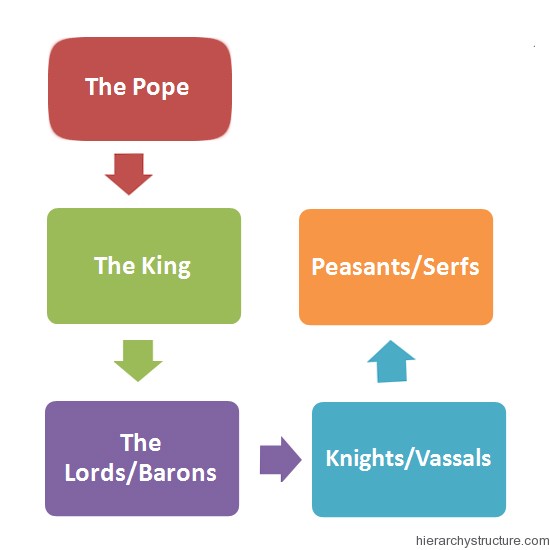Feudalism is defined as the social and political code of conduct, which developed over the Central and Western parts of Europe,gradually after the collapse of the Roman Empire. The main characteristic of the Feudal society was that all the political and military powers were vested in the hands of the land owners.
In the Feudalism social hierarchy, the land was granted by the landowner to the people of the lower classes in return for the military services and other duties. The feudal society was prevalent during the middle ages, between the ninth and fifteenth centuries. Social mobility was minimized during the period due to the rigid religious, social and economic feudal systems of the feudal society. Following are the major levels of this Feudal hierarchy:

- The Pope
- The King
- The Lords/Barons
- Knights/Vassals
- Peasants/Serfs
The Pope
In the feudal society, it was believed that the land belonged to the God. The kings were the owner of all the lands but the highest position that was prevalent in the society, even above the king was that of the Pope. The Pope had the right to interfere, in case any type of unfair decisions or unfair actions were undertaken by the King.
The King had to answer to the Pope in those cases.The Pope had the sole authority to unseat a King and to put another King in his place.
The King
As per the Feudalism social hierarchy, the king owned all the land and allowed the trusted nobles to govern a part of the land in return of other services. The lands were passed on through heredity.The parts of the land being taken by the nobles on the lease were called as fiefs.
The Lords/Barons
The Lords were controlled by the king. They used to be the wealthy owners of the land and they used to provide the lands on lease to the Vassals and Peasants. The Lords generally ruled over a specific Manor.In return of the Manor, the Barons had to pay homage to the King. They had to provide troops for the King in times of need.
The Barons also had to pay taxes, on demand by the King. In case of death of a Baron, his Manor was passed on to the next generation by heredity.
Knights/Vassals
The Knights were military men. The Barons provided a part of their fiefs to the Knights on lease, in the same way as the King had leased them. In turn, they expected protection for their families and the King from the part of the Knights.
Peasants/Serfs
The Peasants or Serfs were at the bottom of the Feudalism social hierarchy. They were basically divided into two types such as the free peasants and the unfree peasants. The free peasants worked on their independent businesses and paid a certain amount of rent to the Lord for utilizing their provided piece of land. They generally worked as carpenters, weavers, bakers and blacksmiths etc.
On the other hand, the un free peasants did not pay any money for utilizing the land given by the King and in turn, solely worked for the King.
Know more about European feudal system Click Here
